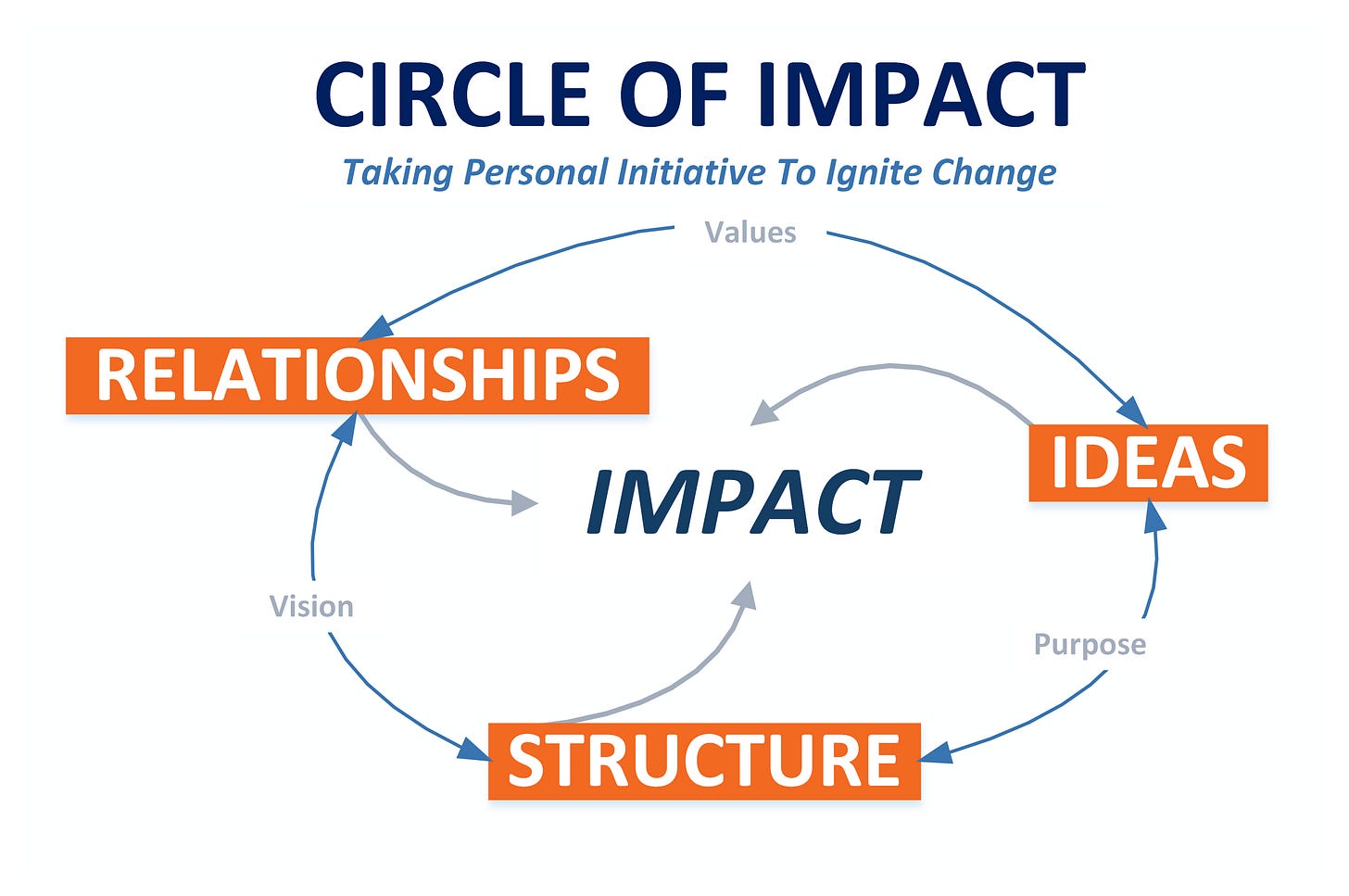A Persistent, Residual Culture of Leadership
Stop running your organization, lead it as a shared culture of impact
What Defines a Business?
Recently, I was filling out a questionnaire about my business, Circle of Impact. There was a slot for what kind of business it is. There was no selection for “GREAT!”. There was no selection for “Coach, Consultant, Trainer, Writer, Speaker, and Transition Expert.” I usually put Consultant because from the descriptors provided it is the only one that is remotely close to what I do.
It is a similar story that I get when a request to consider marketing services comes through. When I am asked who my preferred client base is I say either,
“People in transition” or
“Organizations that are in transition that seek to elevate the leadership capacities of their people.”
Their response is usually “We don’t know how to market to that.” See the flaw in that logic?
How you define your business determines the business that you are in. It may be that the person who is your client is the head of HR. But you are not selling to them. You are offering to solve some problem that they have. Why else would they listen to you?
Your clients want you to impact their organization.
Impact is a change that makes a difference that matters.
How you define leadership determines what kind of leader you will become. If you see leadership as a function of your role in your business, then your leadership will be defined by that role.
Increasingly, I see leadership as a diminishing force in organizations. It gets simplified by this question.
“Are you running your business or leading your business?”
I know a lot of people who can run their businesses well. But they are not leading it. To lead it they must have a mindset for impact beyond the numbers that quantify the operation of the business. Ask.
What difference are we making?
What is the impact that we are having with our clients?
More importantly, what impact are you having with your staff or your team?
One of the chief ways to lead your business is to facilitate growth in the leadership capacities of your people. This means that you first recognize that they are already leading. Secondly, their leadership can be nurtured for greater impact. In other words, if you were to decide to release your people to lead, you would discover a phenomenon taking place that was hidden in plain sight to you.
Even having invested over 30 years in leadership work, I was well into my sixties when I began to see what leadership truly constitutes in an organization. The same is true for families and communities. Leadership is a function of how we live, even at work. All leadership begins with personal initiative to create impact that makes a difference that matters. This is what is missed when we settle for running our businesses instead of leading them.
If you grasp the implication of what I am saying here, you will see that the role of the senior leader of an organization is to facilitate the leadership of others. This is what it means to create a culture for leadership. It is taking what is already there, shining a light on it, and with gratitude and appreciation ask, “How can WE expand our leadership impact.”
The Distinguishing Mark of a Leadership Culture
A few years ago I conducted a series of webinars for a division of a global corporation. This company had experienced some significant public failures over the previous decade. My work with the company did not touch on those failures. My work was more about leadership capacity building.
On a visit to the company to meet with the team that hired me, I was introduced to an executive assistant of one of the vice presidents. She was very formal with me. I asked about her time with the company. She was a long-term employee, for close to 30 years. I told her how much I had enjoyed working with their people. I then said to her:
A company is not defined by its leadership nor its tragedies. A company is defined by what I call “a persistent, residual culture”.
This culture persists because of a set of shared values that are the defining culture of the company.
It persists because it resides in the relationships of the people who spend their lives working at the company.
You are still here because you love the company, and I know it must be heartbreaking to see the hard times that you all are in.”
Immediately, her formality and defensiveness left her because I had acknowledged and validated the contribution that she had given to the company.
A Culture of Values and Beliefs
In times of uncertainty, we need to be clear about the values and beliefs that define us. In a social environment, whether a family or a business or a community, shared values are the foundation for a culture that values the leadership impact of people.
Leadership impact is the change that makes a difference that matters.
If a person’s work doesn’t matter, what is the problem here? Is it how the job has been defined, structured, and resourced?
If a person’s work doesn’t matter, how can a supervisor manage that person?
Is doing the job nothing more than a lower-level form of running the business?
How you fall into these scenarios represents the values that are actually alive in your company. How the persistent, residual culture of relationships is supported tells me everything about the impact an organization is having. It takes just a minute or two in conversation with someone to discover what this culture looks like.
Having clear values that define the company trains minds to see impact. As a result, the senior leadership of the organization has two responsibilities that support a culture of leadership.
First, it is to show the company’s values are expressed through the work of the company.
Second, it is to facilitate the development of leadership through programs of capacity building and support. What gets trained and supported becomes the leadership character of the business.
Where Does This Culture Come From?
It is a default principle that senior leaders create culture. My experience shows me that culture creation is a company-wide process. Culture is not a package good that gets opened and distributed like office supplies. Culture is the social structure born out of the shared experience of people in relationship to one another.
In a hybrid office era, this culture development is going to be harder and more crucial to create. A persistent, residual culture of relationships is a culture of values that bind people together with a common purpose to serve. This is all the more reason why leadership is not a role, but a shared experience of impact creation and that culture creation is not the job of the senior leader, but an initiative that should engage everyone in the organization.
In other words, the environment for leadership is changing. It is diminishing as an organizational role and growing as a function of human initiative.
How Do We Nurture A Persistent, Residual Culture?
It begins with acknowledging that it exists. Celebrate it. Validate it. Encourage it. Identify its impact. Then say Thank You.
To create a sustainable culture the Circle of Impact model of leadership provides an answer.
A culture is formed by Ideas (values, beliefs, purpose, vision, etc.) that draw people together for a shared purpose in their Relationships. However, the shared values should matter in their interaction with one another. The values should not be shallow abstractions. Relationships don’t exist in a vacuum. Because they exist in the real world, they need Structure. The organization’s structure is where the culture is established and nurtured. A shared belief system takes the Relationship dimension and transforms it into the social structure that operates through the organization’s structure.
The remarkable thing is that these cultures are strategic, not tactical. They are essential to the well-being and effective functioning of the whole organization. Ironically, these cultures can’t be delegated. They are not mechanical, but organic. They grow up out of the grassroots of the organization.
Senior leadership provides for the nourishment and care for the culture. However, at the end of the day, this culture transcends every person in the organization. It will survive bad leadership, hard times, and employee turnover. Seeing this is where I discovered these persistent, residual cultures.
If you want a healthy organizational culture, then begin by elevating the leadership capacities of the people who are at the lowest echelon of the company. If you want a healthy family, you begin with your children. Nurture their leadership capacities. In both settings, train them, mentor them, support them, and celebrate their impact. As a result, problems get solved. Communication improves. And the pent-up demand for more leadership is released throughout the whole organization and the family.



